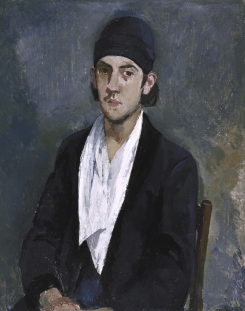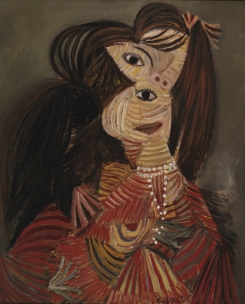Image

Constant Nieuwenhuys is born in Amsterdam on July 21st 1920 as the first son of Pieter Nieuwenhuys and Maria Cornelissen. His father works as a manager at a company. A year later his brother Jan is born. Both boys grow up to become painters.
At a young age Constant draws passionately, he reads both prose and poetry and the first instrument he learns to play is his mother’s mandoline. Music will play an important part throughout Constant’s life. He plays the violin, the guitar and learns how to play the cymbalon when he is fourty-five, following lessons with Jenö Horvath. In his teens he learns to read and sing notes at the choir of the Jesuit College. As an adult Constant becomes enchanted by Gypsy Folklore music which is mostly improvised.
Constant paints his first oil painting, Jesus at Emmaüs, at age sixteen. He buys pigments and a sackcloth from a housepainter. Due to Constant’s Roman-Catholic upbringing his earlier works often depict religious images. At age twenty he abandons the catholic church and religion all together. Between 1940 and 1942 Constant attends the Rijksacademie van Beeldende Kunsten (State Academy of Fine Arts) in Amsterdam. Here he learns to apply his natural ability better as he explains to Jean-Clarence Lambert in 2000 for the book L’Atelier Amsterdam. "I drew from life, I studied anatomy, not only human but also that of animals." He discovers Delacroix through reproductions and has high regard for the Flemish painter Constant Permeke. Although as he says in his own words "In fact I like no artist in his or her entirety, only certain works."
Between 1942 and 1943 Constant lives and works in Bergen. It’s in Bergen that he’s introduced to the work of Cézanne, which will prove an inspiration to him throughout his career. Cézanne’s influence can be clearly seen in his Self-portrait from 1942.
At the start of 1943 the Germans evacuate Bergen to build the Atlantikwall. Constant and his wife Mati van Domselaer, daughter of Jacob van Domselaer, return to Amsterdam. They move into an appartment at Sarphatipark 42. Constant goes into hiding to avoid the labor camps (‘Arbeiteinsatz’). When he refuses to register himself with the ‘Kulturkammer’ he is not allowed to practice his profession, buy materials or exhibit his work. To continue working he uses linen in the house. When all sheets and tablecloths have been turned into paintings he boils them and starts over. Hans Wiesman, a friend of Constant buys his Self-portrait (1942) and saves the work from the boiling pot.
During the war his brother in law, Jacob van Domselaer, comes to stay with the couple to escape the labor camps. He is the one that introduces Constant to the works of the philosophers Spinoza, Descartes, Kant and Karl Marx. The latter has a huge impact on Constant’s ideas about the role of art in society.
In 1944, during the Winter of Famine, Constant’s first child, Victor is born. After the war the family moves back to Bergen only to return to Amsterdam shortly after in 1946. They move to the Henri Polaklaan, around the corner from Artis, the Royal Zoo. Having the zoo at close proximity will prove a big influence on his work. He’s especially fond of lions which have a starring role in many of his later paintings.
From 1945, after a period of captivity, Constant liberates himself. He experiments with techniques and styles. He is inspired by Cubism and painters like Pablo Picasso and Georges Braque. He creates work in their styles in search of his own. In 1946 his first daughter Martha is born followed by his second daughter Olga in 1948.
Early Period 1920-1947
CoBrA 1948-1951
Towards a Synthesis of Art 1952-1956
New Babylon 1956-1974
Situationist International 1958-1960
Late Period 1974-2005


